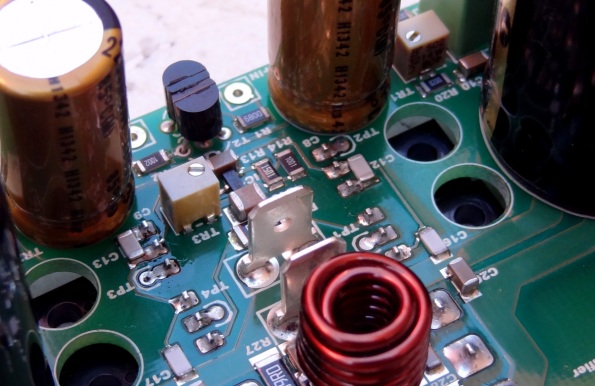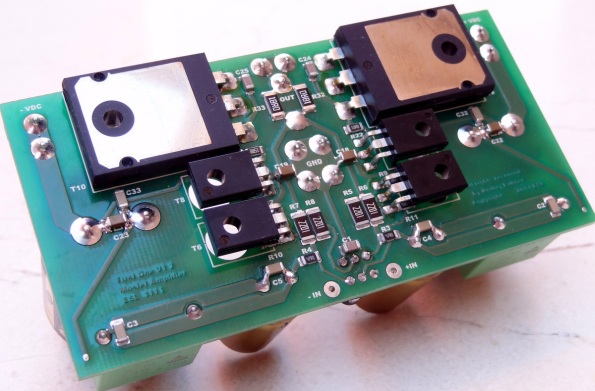First One Amplifier Module
The First One Amp module [link] is a high performance (High Fidelity?) and yet very affordable class AB current-feedback amplifier module. It establishes a benchmark for price/performance.
Developed by “Lazy Cat” (LC) at diyaudio, it is the big-brother commercial version of the DIY VSSA (“Very Simple Symmetric Amplifier) [link] and incorporates all the knowledge obtained from that project. Whereas the VSSA was fully open and fully diy, the First One amplifier is available as a factory built and tested module. Available for diyers as well as OEM to manufacturers, the module has been seen in a finished amplifier for a road show in Slovenia [link].
Photo of First One’s little brother: completed VSSA module (built by LC):
FIRST ONE MODULE
Since I am new to this module and was not aware of the VSSA, I’ll use this and following post to gather my knowledge for my amplifier build. The information is mostly from the diyaudio threads, but there it is spread out all over the place and hard to find.
Photos of the First One Amplifier Module.
Use of name-brand “audio grade” components…
The current version is V1.2. There is a V1.3 that has been developed but not quite yet available for sale. For those of us with V1.2, LC has promised to send modding instructions but only to those that have completed the build of the amp.
Thermal coupling for these two transistors. The schematic is not public since this is a commercial product.
Notice the adjustment pots (TRx) and the measuring points (TPx)
Output Power transistors are Semelab “ALFET” double die MOSFET N and P-channel pair, rated at 250 W and 16 Amp continuous current. These are specially designed for audio applications [link]:
- The N-channel device is: ALF16N16W/ALF16N20W [link]
- The P-channel device is: ALF16P16W/ALF16P20W [link]
SPECIFICATIONS
Module Size
100 x 50 x 40 mm (W x D x H). [link]
Supply Voltage
+/-40 V to +/-63 V
DC coupled
The amp modules are DC coupled, no capacitor in front of the input stage.
Measurements
I’ll compare the specifications of the First One module (FO) [link] vs an old Hitachi amp [link] and an Adcom amp:
| Parameter | First One |
Hitachi HMA-7500 |
Adcom GFA-5300 |
| Max Power 8 Ohm | 150 Watt 0.05 THD | 80 Watt 0.005 THD | 80 Watt 0.018 THD |
| Max Power 4 Ohm | 230 Watt 0.05 THD | 80 Watt 0.005 THD | 125 Watt 0.018 THD |
| Bandwidth | 3 Hz to 3 MHz (-3dB) | 5 Hz to 100 KHz (-1dB) | 3 Hz to 130KHz (-3dB) |
| THD | 0.0034% (100 Watt) | <0.005% (80 Watt) | 0.02% (125 Watt, 1KHz) |
| IMD | 0.003% | <0.008% | <0.07% |
| SNR | 110 dB | 118 dB | >100 dB |
| Input Impedance | 10 Kohm | 47 Kohm | 50 Kohm |
| Damping Factor | >2000 (4 ohm) | 100 (8 ohm, 1KHz) | >350 |
| Year Introduction | 2014 | 1980 | 1995 |
According to published specifications, the First One amp has very impressive specifications and overall best of the bunch. The old Hitachi has still has very impressive specifications (but at a much lower max power).
Damping factor
Measurements performed in order to determine Zout and consequently the damping factor (DF). A sinusoidal signal of 100 Wrms at 20 Hz, 1 kHz and 20 kHz was passed onto a 4.08 Ohm load resistor, measured with FLUKE 289 True RMS Multimeter and here are the results. [link]
20 Hz, 100 Wrms/4.08 Ohm:
- DF(20 Hz)=Rload/Zout=4.08 Ohm/0.00121 Ohm=3372
1 kHz, 100 Wrms/4.08 Ohm:
- DF(1 kHz)=Rload/Zout=4,08 Ohm/0,0004 Ohm=10200
20 kHz, 100 Wrms/4,08 Ohm:
- DF(20 kHz)=Rload/Zout=4,08 Ohm/0,00162 Ohm=2519
Very large damping factor by itself likely means that the amp itself would not be the limiting factor for controlling the oscillations in the speaker. This means that other factors (such as speaker cable impedance) would contribute more to the damping factor seen by the speaker. The speaker’s own impedance is the mayor contributor…
A PERFECT MATCH WITH R2R DAC?
Seems a perfect match for the upcoming discrete R2R DAC. The amp being single-ended (and DC-coupled) can take the output signal straight out of the resistor ladder. In addition, being wide-band would further benefit from R2R conversion (as opposed to delta-sigma) because the R2R DAC does not generate high frequency noise.









Hi!
Thanks for your blog, I like to read of other people’s opinions and how they realize them.
As to the noise, I think the DAC has a output filter, and/or the Pre and Amp an input filter, so that the noise, if there is theoretical any, wouldn’t pass and be amplified.
Look for low pass filter.
Regards,
Matthias
Is this available?
It is available now as v1.4 and reviews are great http://www.diyaudio.com/forums/swap-meet/287335-fs-first-one-m-v1-4-power-amplifier-module.html
Orange County Bail Bonds
Nigeria Politics
aceite de canola
free movies online without download
scrap metal
click here
peixoto bikini
invitatii de nunta
Great write-up, I am regular visitor of one’s website, maintain up the excellent operate, and It’s going to be a regular visitor for a lengthy time.
I’ve ordered a pair of FO-L modules last june and after a 3 months delay I eventually received them. At first glance could clearly see that they were refurbished with some parts reworked on the PCB. Even though Andrej insisted they were brand new.
Two weeks later one of the amplifier channels failed. With a loud bang then hum. I was in the garden, by the time I rushed back home the left speaker, Focal Aria 926 was smoking. It was damaged beyond repair. On the amplifier two of the transistors popped out and burned the PCB as well. I was promissed a free replacement from Andrej but ever since he avoid any email or forum reply.
I sold the other amplifier channel to a dude which need a spare one, as it is, on an ebay listing with $50. 3 weeks later I got an ebay dispute. He says that the amplifier bursted in flames after just half hour of use. I didn’t bother dealing with and refunded the money.
Back to Andrej, aka Lazy Cat, all my emails went one way without ever reply. Messages posted on his facebook page and diyaudio forum board on his thread went unaswer then couple of hours later dissapeared. Later on I was banned. WTF ? This already smells like a scam. And DIYaudio mods seems to be involved too since they remove my messages.
Now his FB page went down, no answer to emails. On one of the last email he just discarded his liability saying that was due to improper operation. Later on after I explained all details and sent pictures with the installation he just switched the blame to the power supply. I used a SMPS1200 from hypex which was also sold by him and he recommended against any other alternative.
I plan to fill a claim with the consumer protection agency within his jurisdiction.
He can’t stand behind his claims or warranty, sells misleading products, expensive fireworks which burned my very expensive Focal speaker beside his junk amateurish improvisations.
yeah, I had similar experience with Lazycat, he told me my cables made it oscillate and did nothing about repair. I wont buy from him again.
I got the same, VSSA modules blew up, was my cables, too capacitive. He was unhelpful and took no ownership or interest in the problem. Fortunately I didn’t loose a driver.